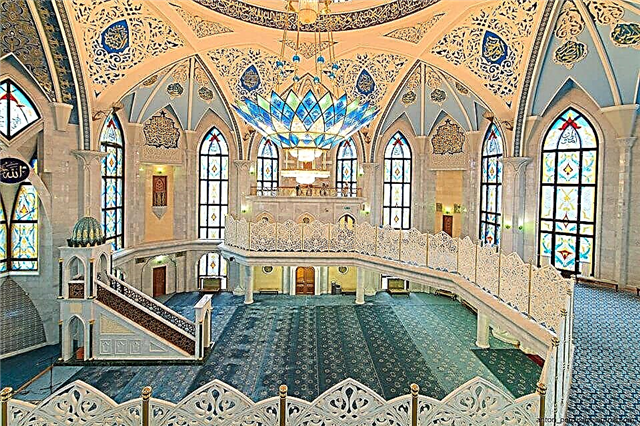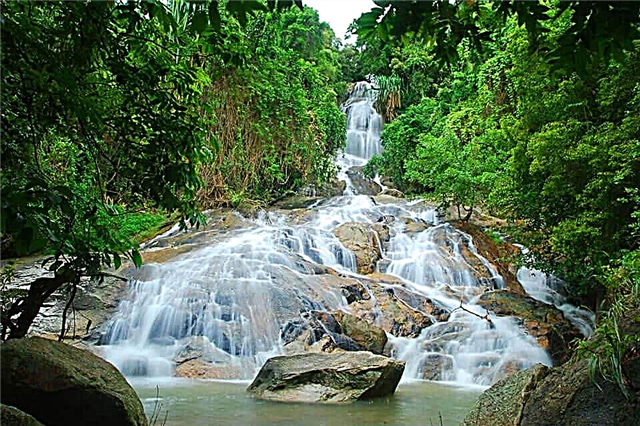Address: India, Abaneri
Built: between IX and XI centuries
Depth: more than 35 m
Coordinates: 27 ° 00'25.8 "N 76 ° 36'23.4" E
Content:
Description
In the minds of many people, a well is a small reservoir into which a container for water intake is lowered on a chain. If you go to the Indian town of Abaneri, located in the state of Rajasthan, then the widespread opinion about wells changes radically.

Chand Baori aerial view
In a mysterious and densely populated country, where every drop of fresh water, literally, is worth its weight in gold, you can see with what trepidation people treated the gifts of nature. The Chand Baori stepped well is considered a real architectural miracle, which attracts the attention of not only numerous tourists, but also historians, archaeologists and architects.
Since ancient times, India has aroused genuine interest from residents of other countries: its culture, many religions and a huge number of attractions simply cannot go unnoticed. In this country, people have always been able to build. Temples, cave monasteries, tombs and wells in India even today are considered unique masterpieces, many of which are under the protection of UNESCO. The Chand Baori well in Rajasthan is one of the greatest structures, striking in its size and shape.
It is impossible to find anything like this on our planet: step wells, which more resemble majestic temples, were erected only in India. The well in the city of Abaneri is considered the largest and most beautiful in the entire country. Near it you can always find excursion groups consisting of tourists who have come to a mystical country from all over the world.

General view of the well
Chand Baori: a small historical background
Many travelers, barely looking at the photo of the Chand Baori well, immediately decide to travel to a small town where you can see this magnificent monument of history and architecture. The name of one of the most amazing sights in India comes from the word "baori", which means steps. Historians still cannot name even an approximate date for the appearance of the largest well in the world in India. Many of the experts claim that Chand Baori was built approximately between the 9th and 11th centuries (currently the official version), while others say that a huge reservoir for collecting drinking water appeared 600 years before the advent of our era. Alas, no chronicles mentioning the construction of this architectural miracle have survived to this day. True, there is an ancient legend, in which almost the entire population of Abaneri believes: it says that the Chand Baori well was built ... in just one day. Naturally, only otherworldly forces could meet such deadlines: according to legend, demons built a water tank. Unfortunately, it is also not possible to find out the date of this prediction.

Chand Baori Well: an architectural masterpiece of India
If you look at the outer facade of the well, you might get the impression that there is a small fort in front of you, which was built by the British during their colonial rule in India. Naturally, this impression is deceiving: one has only to go inside and see a huge deep well, reminiscent of an inverted pyramid. On three of its walls, the craftsmen built steps along which it was possible to go down to the water. The depth of Chand Baori is just over 30 meters, the number of steps is 3,500!
On one of the walls you can see a huge temple, in which religious rituals were performed in ancient times. The water in the Chand Baori well accumulated during tropical rainstorms, and thanks to the competent calculations of an unknown architect, it remained in the reservoir for more than six months. The climate throughout the modern Indian state of Rajasthan is considered arid: only three months a year there are tropical showers, the rest of the time it becomes problematic to find potable water.

View of the temple of the gods Durga and Ganesha
The Chand Baori well was mostly filled with rainwater. A small underground source was not enough to meet all the needs of the populationwho lived in Abaneri and its surroundings. Due to the great depth, the life-giving moisture evaporated only slightly, in addition, the water in the well did not overheat and was suitable for drinking for a long time. True, today only a desperate traveler can decide to drink from an ancient reservoir: in the 19th century, the British even issued a decree prohibiting the use of water from Chand Baori. The reason why this law was passed becomes clear to everyone who looks at the polluted bottom of this well, overgrown with algae. The fact is that the Chand Baori well, in addition to serving as a reservoir for fresh water, was also a sacred place: it was possible to enter a multi-level temple built right in one of its walls only after washing. Indians were purified, as you might guess, directly in drinking water. Because of this, the pilgrims and the indigenous population of Abaneri were constantly plagued by parasites and outbreaks of infectious diseases that spread throughout the country.

All the steps of this well had no fences: it is not possible to calculate how many people said goodbye to life here, having fallen from a 30-meter height. Firstly, no one kept these terrible statistics, and secondly, as mentioned above, even in our time it is impossible to accurately determine the date of construction of Chand Baori. The Indian authorities allow everyone to visit this attraction, however, in all tourist avenues, they ask tourists not to feel their sense of balance, and even more so, not to swim or drink water from a well. Local residents still descend to the muddy waters and bathe in them, because according to their religion, only after this ritual can you go to the temple and turn to the higher powers with prayer. Moreover, it is necessary to cleanse oneself in the well before visiting the nearby temple "Harshat Mata", built in honor of the goddess who gives man happiness, joy and prosperity.

Chand Baori well in Rajasthan: a memo to a tourist
Nowadays, in the Chand Baori well, which is the oldest architectural masterpiece, pilgrims wash only their hands and feet: caretakers keep order and do not allow swimming in dangerous water, which, according to bacteriologists and parasitologists, can “kill a person in 2-3 days ". Despite this, quite often in the Indian press there are reports of deaths in this sacred place. Mostly local children fall into the muddy waters, wishing to freshen up during the hot dry season. In addition, isolated cases of the death of tourists in the Chand Baori well were recorded. For this reason, it was decided to enclose the 30-meter tank with a railing. Naturally, no fences will save a person who decides to walk the 3,500 steps and get to the niches where the sculptures of the deities of Ganesha and Durga are located.

View of the steps of the Chand Baori well
No matter how great the desire to show off your skill in front of other tourists, it is best to refrain from going down to the bottom of the well. You can also take stunning photos of Chand Baori at the railing of this huge structure. Be especially careful during the monsoon season.: at this time, all the steps become slippery, and keeping balance on them becomes a rather difficult task. To get to the most beautiful and deepest well in the world, you need to take an air flight to the city of Jaipur.From there you can take a sightseeing bus to Abaneri. You should not use the crowded public transport, it is best to wait for the formation of the excursion group and take a comfortable bus to the Chand Baori well. One of the most amazing sights in India is located just 95 kilometers from Jaipur.











